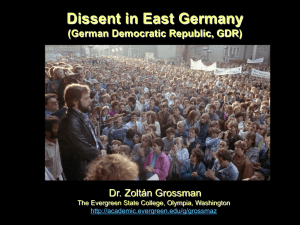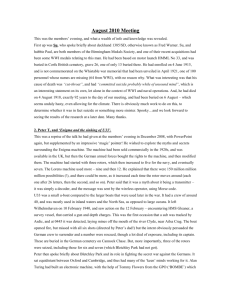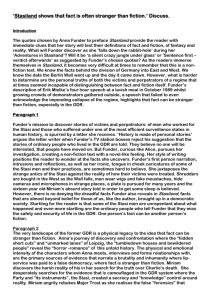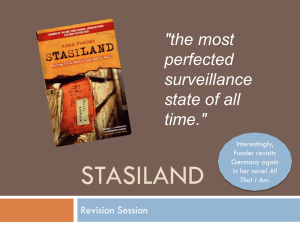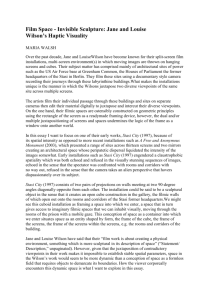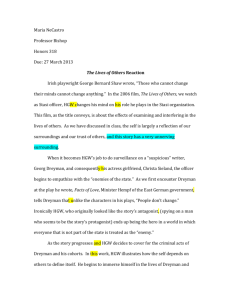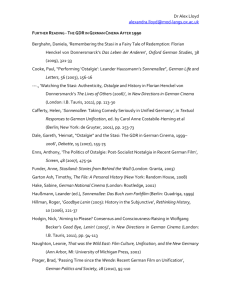power/knowledge failure
advertisement
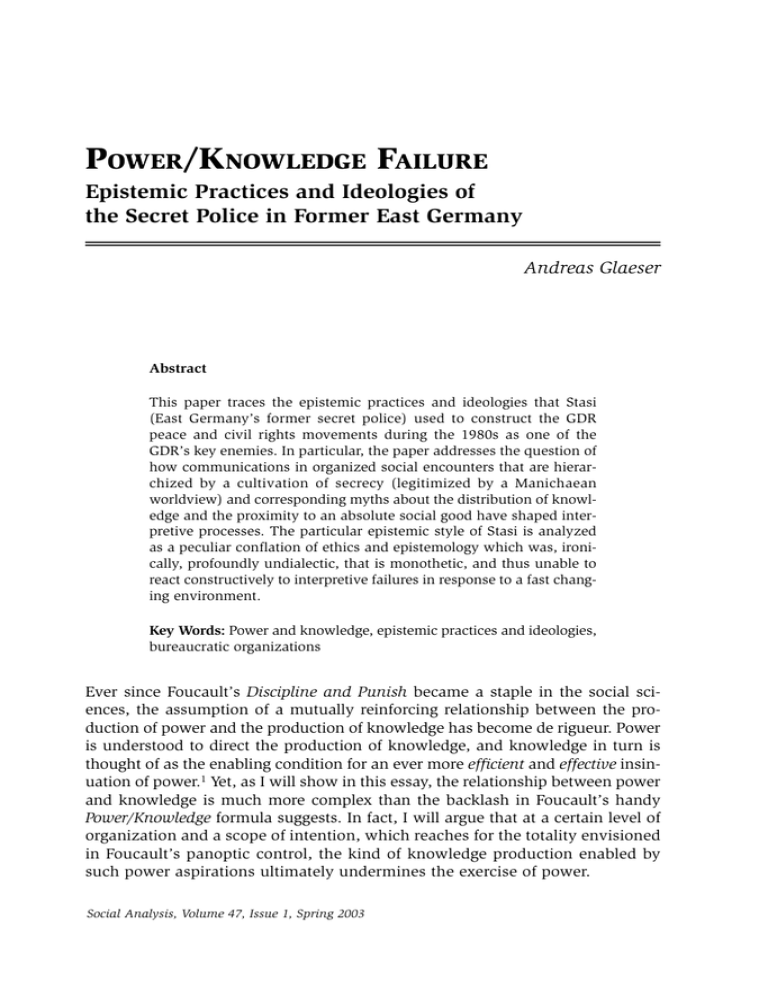
POWER/KNOWLEDGE FAILURE Epistemic Practices and Ideologies of the Secret Police in Former East Germany Andreas Glaeser Abstract This paper traces the epistemic practices and ideologies that Stasi (East Germany’s former secret police) used to construct the GDR peace and civil rights movements during the 1980s as one of the GDR’s key enemies. In particular, the paper addresses the question of how communications in organized social encounters that are hierarchized by a cultivation of secrecy (legitimized by a Manichaean worldview) and corresponding myths about the distribution of knowledge and the proximity to an absolute social good have shaped interpretive processes. The particular epistemic style of Stasi is analyzed as a peculiar conflation of ethics and epistemology which was, ironically, profoundly undialectic, that is monothetic, and thus unable to react constructively to interpretive failures in response to a fast changing environment. Key Words: Power and knowledge, epistemic practices and ideologies, bureaucratic organizations Ever since Foucault’s Discipline and Punish became a staple in the social sciences, the assumption of a mutually reinforcing relationship between the production of power and the production of knowledge has become de rigueur. Power is understood to direct the production of knowledge, and knowledge in turn is thought of as the enabling condition for an ever more efficient and effective insinuation of power.1 Yet, as I will show in this essay, the relationship between power and knowledge is much more complex than the backlash in Foucault’s handy Power/Knowledge formula suggests. In fact, I will argue that at a certain level of organization and a scope of intention, which reaches for the totality envisioned in Foucault’s panoptic control, the kind of knowledge production enabled by such power aspirations ultimately undermines the exercise of power. Social Analysis, Volume 47, Issue 1, Spring 2003 Power/Knowledge Failure 11 I will make my case by analyzing the peculiar interplay between interpretation and control in the efforts of Stasi, the secret police of the former GDR, to deal with the 1980s East-Berlin civil rights movement. Thus, I will treat Stasi’s efforts as an exercise in object construction (cf. Daston 2000; Fabian 1983; Hacking 2002; Said 1978) in which certain kinds of practices and ideologies are mobilized to both understand and control the movements. I will show how every move at control is enabled by some kind of knowledge, and every reaction to control is used to create further knowledge. Yet I will also show that in the case of Stasi and the opposition, instead of augmenting power, this dialectic ultimately undermined its very base. What I am offering here is, then, a case-based constructivist critique of what appears to me as an overdrawn constructivism. Two puzzles lie at the heart of my investigation. The first concerns a considerable disjuncture between the self-understanding of the GDR peace and civil rights movements during the 1980s on the one hand, and its interpretation by Stasi on the other. For although most of the GDR civil rights activists have maintained socialist ideals almost to the very end of the GDR, aiming at a reform of their country rather than at a revolution of its social, economic, and political structure,2 Stasi has cast them as “hardened enemies of the state set upon overthrowing the achievements of socialism.” Secondly, Stasi never produced a thoroughgoing investigation of how the peace and civil rights movements might endanger the GDR regime: its dangerousness was much rather a forgone conclusion. From the vantage point of a state security agency such as Stasi, this is troublesome for two reasons: (1) Stasi did indeed deploy considerable resources to battle the peace and civil rights movements; and (2) Stasi’s rigid understanding prevented it from devising flexible responses to changing trends within the movements. Worse, perhaps, Stasi’s actions ultimately added to the activists’ accelerating disenchantment with real-existing socialism and to their increasing radicalization. It can thus be argued that ironically, Stasi helped in part to make an enemy, although, it never was the kind of enemy Stasi thought it was. Before I can delve into the ways in which Stasi did produce its object, it is important to remember that socialism was working with a Hegelian rather than Marxian model of social transformation (Glaeser forthcoming). The idea behind this model was that the very success of socialism is contingent upon the adoption of socialist ways of thinking, guiding socialist ways of acting. An enormous proselytizing effort geared at aligning the individual intentionality of every citizen with the collective intentionality decreed by the party was thought to be the means of achieving this goal. Given the importance thus attributed to adjusting the citizens’ consciousness to the latest party line, it is perhaps not surprising that the party kept demanding tokens of allegiance. To collect these tokens, the sum total of which was interpreted as a significant indicator for the state of the socialist project, the state had organized a dense network of occasions in which individuals could publicly produce their tokens. The largest number of such occasions was provided by the participation in propaganda events that furnished the basic rhythms of the socialist calendar. They ranged from the regular participation in the activities of the mass organizations, and 12 Andreas Glaeser large-scale events such as May Day or Day of the Republic3 parades, to participation in local and national elections. Stasi complemented the propaganda efforts of the party in two important ways. Firstly, Stasi had to ascertain that the tokens provided were indeed true measures of loyalty. Painfully aware of the possibility of faking these tokens for strategic purposes, the party state was drawn to having the truth claim inherent in the production of the token validated by prying on expressions of faith in party and state in supposedly uncontrolled contexts. On the basis of this model of truth, it is a consequence that national opinion research was not done by some social scientific enterprise but by the secret police, which regularly supplied various levels of party and state with so-called “atmospheric reports.”4 Secondly, Stasi was supposed to attend to all those cases where propaganda had failed to produce its desired effects; that is, cases where the at least passive allegiance of a citizen became doubtful. This was important because, on the basis of its consciousness driven model of social transformation, the party feared that nonaligned citizens might disseminate their negative attitudes to others, thereby spoiling the party’s efforts to institutionalize socialism effectively. In consequence, the consciousness driven model of social transformation, the keen awareness of the possible trappings of semiotic processes, and the fear of contagion of negative attitudes toward state and party moved the secret police into a key pillar of governance in the GDR. The apparatus of soliciting tokens of allegiance can be understood as a continuous consciousness testing operation. Stasi typically got wind of ‘missed opportunities’ to pay allegiance through its countrywide web of secret informants which deeply penetrated all organizations in the GDR. Once suspect of questionable loyalty, Stasi began to investigate the reputation of citizens, inquiring about them at work and in the neighborhood. What Stasi was fishing for in these investigations were demonstrated attitudes to state, party, and socialism: they were trying to assess commitment. If suspects were involved in some activities deemed problematic by the state, Stasi would organize an Aussprache, a “talk” between the suspects and their employers, their local governments or the police, about what had been going on. Suspects were thus reminded that they were violating public intentionality and possibly the law; they were asked to be mindful of the world-political situation demanding of them not to undermine the struggle of the state for justice and world peace. If suspects were amenable to such “educational measures” henceforth demonstrating at least passive loyalty, then this was the end of the story. Temporal lapses of allegiance were not only pardonable, but they added a distinct flavor of realism to what the party called “the struggle for the minds and hearts of the people.” If, however, suspects continued with activities that could be read as lacking commitment, Stasi’s control activities became ever more forceful. General background checks and “talks” gave way to “operative person checks” (MfS guideline 1/81), which might lead to starting an “operative dossier” (MfS guideline 1/76). And at every new level, Stasi found ways to let suspects know that they were continuing to investigate them; every refusal with requests to Power/Knowledge Failure 13 comply was interpreted systematically as a hardening oppositional attitude to the state. The members of the peace and civil rights movements in Berlin during the 1980s were often propelled to organize themselves, precisely because they had gone through a spiral of refusing to pay a particular token of allegiance followed by “educational measures” by the state which, in turn, made them even more weary of paying other tokens of loyalty. For most, this process began sometime in high school, when they refused to approve the relegation of a fellow student or the invasion of Czechoslovakia by Warsaw Pact forces, or to cave in to the demand not to wear jeans, not to listen to Western pop music, etc. Seeing the Berlin Movements through Stasi’s Eyes The Stasi’s branch chiefly responsible (MfS guideline 2/82) for what was called the “political underground” which included the various peace and civil rights groups in the GDR was the so called “Line XX”5 which had essentially two functions. Firstly, it had to screen all government institutions, all mass organizations and parties (except for the ruling socialist party), the artistic and literary scenes, the mass media, the public health sector, sports, and all educational and most scientific institutions for possible enemies of the GDR operating within the country. Stasi defined enemies as “people, who in groups or on their own intentionally develop political and ideological views and attitudes which are alien to the essence (wesensfremd) of socialism, and thus endanger through their conduct … the socialist state and society” (Suckut 1996: 121). Secondly, once such enemies were identified by the process outlined above as those recalcitrant human beings who did not comply with requests to step back into line, they had to be controlled, either by means of the political penal justice system, in which case Stasi had to collect the necessary evidence in the “operative dossier” to instigate and support a “judicial investigation.”6 Where using such means was deemed to entail politically undesirable consequences, for example, because they might weaken the GDR’s international reputation, Stasi reverted increasingly to what it called “decomposition” (Zersetzung), that is, social and psychological methods of control, aimed at undermining the self confidence of individual persons and their position in a particular group. For Stasi, the threshold between somebody who has merely committed a “politically immature act” and an enemy was precisely the regular engagement in “negative-inimical activities” against better advice. In accordance with the logic of the consciousness driven model of social change, the more public such activities were the more dangerous they were estimated to be. Thus, a public appearance deemed rather spectacular could turn someone rather immediately into an enemy. This threshold was roughly equivalent with starting an “operative dossier.” Martin Boettger, for example, a core member of the “Initiative for Peace and Human Rights” (Initiative für Frieden und Menschenrechte) decided, at one point, to vent his long harbored disagreement with the state publicly, to see how far the group could go. As a young physicist working for Robotron, one 14 Andreas Glaeser of the GDR’s top high-tech companies, he simply showed up for the 1975 May Day parade with a big poster questioning the GDR’s human rights record. That year nothing much happened as nobody—much to his surprise—seemed to notice. The year after, however, showing up with a similar poster, he was pulled out of the train and promptly interrogated by Stasi, which started an operative dossier with the intention of proving eventually that he had violated the “antistate inflammatory speech” article of the penal code. Most activists, however, did not come on record for spectacular public appearances but for surfacing in the perimeter of some person already under investigation. They became notorious for entering more sustained contact with such persons. Although Stasi had several ways of getting wind of such sustained contact,7 by far the most important one was the report of a secret informant (literally from the German, “unofficial employees” Inoffizielle Mitarbeiter or IMs for short). Stasi had hired them throughout all walks of life, and in nearly all organizations of the country.8 Although some were blackmailed into collaboration, most were recruited on the basis of what Stasi called “their political convictions” (MfS guideline, 1/79). Most of them were reporting about people, and occurrences and developments at their respective workplaces—other motives notwithstanding, at least also in the belief that they were contributing, in this way, to the development of what they saw as the only conceivable just society, that is, socialism. On a more mundane level, many of them harbored hopes that their contacts with Stasi would contribute in some way to solving either organizational problems (one officer told me, for example, how one informant in a scientific institute ceased to collaborate with Stasi after Stasi had failed to obtain important chemicals for his research); or private ones (for example, in finding a better apartment). Typically this collaboration did not require extraordinary commitments of spare time, as meetings took place once every two to four weeks. However, the informants Stasi needed to spy on the peace and civil rights movements during the 1980s were of a different kind. As it became clear to Stasi that it was rather difficult to recruit informants from within the budding movements, they began systematically to “develop” informants who could be used to infiltrate groups. For such a task, those selected needed to fulfill two preconditions: The outwardly known or quickly verifiable elements of their biography needed to lend support to a credible story of why they were willing to get involved in the movements’ activities (that is, they required a persuasive “legend” in Stasi’s jargon); they also needed to be willing to commit extraordinary amounts of leisure time, as informants had to keep up with ordinary day jobs while attending and organizing group events, and reporting these events to Stasi officers in their spare time. As movement activities could consume nearly all free time of the activists, this also implied that possible key informants had to be motivated enough to live without the support of their own social networks for extended periods of time. Given these requirements, it is not surprising that although there are as many stories about how and why a particular person decided to collaborate with Stasi as secret informants (cf. Müller-Enbergs 1995), there are a few biographical Power/Knowledge Failure 15 characteristics that many of them have in common. Typically, informants were, from early youth, seriously committed to socialism, not just as an idea but as a cause. Frequently, they have also run afoul of the mainstream socialist system at some point in their careers, and were either expelled from the party and/or from other attractive positions within GDR society which, until then, had provided them with a real or imagined venue to live in, in active pursuit of their ideals. Stasi’s offer to collaborate was then understood as either a way to prove their commitment, as a means to rehabilitate themselves, or simply as a new opportunity to pursue their ideals. Often, collaboration with Stasi provided the grounds for a self-identification of the informants as “needed” or even “chosen” by an agency, which was seen as operating at the very center of power, and beyond bureaucratic party hierarchies, hence offering those chosen an extraordinary means of influence. Thus, for many, becoming a secret informant, living in the interstices between the in and out of socialist society, held the promise of being more effective contributors to the development of a good socialist society than they were before. These men and women strongly committed to socialism,9 even if not necessarily to the party in its present form,10 built the key source of information for Stasi’s understanding of the “political underground.” It is important to notice that typically, in this context, operative Stasi officers had absolutely no unmediated knowledge of the persons they investigated. On rare occasions, the operative officer might participate in a “conspiratorial apartment search,” or a direct observation effort to get a glimpse of the person they were investigating. By and large, however, Stasi officers were thus crucially dependent on their key informants as sources for truly relevant information, and thus official Stasi documents never tire to list secret informants as “the main weapon in the battle against the enemy” (MfS, guideline 1/79). Accordingly, the meeting between the informants and their guidance officers (Treff) took a central place in Stasi work, in rules and regulations, training programs, and in organizational narratives. Principally, meetings were held with all the performative accoutrements of secrecy in ‘conspiratorial apartments’ which were typically private flats offered to Stasi for regular use by loyal citizens.11 The guidance officers normally arrived somewhat before their informants to ‘clear the air’, that is, to prevent or minimize contact with third parties, including the apartment provider,12 as well as to make coffee and set the table. The ideal meeting began with some warm-up personal chatter, to proceed then to an intense question and answer period in which the guidance officers asked their informants about their latest assignments, typically in the case of Berlin movements, the last group events attended. Sometimes the informants also provided written reports on special events or materials collected from the groups, such as drafts of petitions, letters, articles, pamphlets, underground publications, or pictures. Often, these meetings were taped to provide the reporting officers with a back up should they wish to rehearse part of the interview. The meeting usually ended with an agreement about the next steps to be taken (e.g., events to attend, people to contact to build a relationship) 16 Andreas Glaeser including a time for the next appointment. At more turbulent times, and toward the end of the GDR, these practices were more the norm than the exception; meetings could also take place immediately after a group meeting, in the dead of night, somewhere in a car. Stasi’s dependence on their informants is reflected in the fact that officers were exhorted to turn the meeting into an event of “high personal value for the informant” (MfS, Hochschule 1985) Thus, officers tried to become a friend or trusted person for their informants. Some meetings were especially designated by Stasi to show special appreciation for their informants. Peter Wagner was the guidance officer of Philip Kaminsky, one of Stasi’s key informants in the Prenzlauer Berg scene. Wagner was an accomplished amateur chef, and on special occasions, after a particularly stressful stretch of work, Peter treated Philip—guidance officers and informants typically used the informal form of address to emphasize their fraternity in socialism—to exotic cuisine prepared and served in the conspiratorial apartment. All of the informants I have talked to also cherished the solemn little ceremonies in which Stasi officers awarded medals to them. Werner Volckert comments: “Only in retrospect does it look kind of silly, especially since I know now how often these medals were conferred. Back then it was quite something, not only my guidance officer was there, but also his boss and they made it into a nice event.” What precisely informants were willing to do to obtain particular kinds of information, how much they shared of what they knew with their guidance officers, whom and what they were willing to report on how truthfully, was largely contingent upon the informant’s motivation to collaborate. Some guidance officers insisted that everything might be important: an activist’s preference for a particular kind of perfume or tooth paste, their erotic fantasies, the quality of relationships with partners, children, parents, and friends. Some informants simply obliged, the enemy had to be defeated after all; others wondered about the uses of some of the information asked for, and decided to draw their own specific boundaries of how far they would go.13 Being well aware of the connection between the motivation to collaborate and the lines of reservation drawn by the informants, Stasi urged its officers to educate their informants politically, to help them develop a clear “enemy-image” (Feindbild), to understand the general party line, and especially to see how the work of Stasi, including the informant’s own particular role, contributed to realizing the revolutionary intentionality of the party. Of course, they also knew, that depending upon whom they were dealing, this kind of ideological schooling, typically nicknamed “red light radiation therapy” (Rotlichtbestrahlung)14 could have rather counter-motivational effects. Often, for secret informants, the whole point of collaboration was to be able to “talk more frankly” with Stasi, since they felt that rather straight-forward, nonformulaic conversations were not possible with the state or party bureaucracies (as this was often cited as one of the reasons why they had failed in their official careers). It is important to understand that these meetings proceeded under what economists would call asymmetrical information, both regarding the identity of Power/Knowledge Failure 17 the interlocutors involved and the substance matter in question. While the Stasi officers knew much about their secret informants’ life, as all informants were thoroughly investigated before being recruited, the informants knew very little about their guidance officers who usually even introduced themselves under an alias.15 While guidance officers were usually encouraged to learn as much as possible about the private lives of their informants if only to assess potential security hazards (debts, alcoholism, etc.), they were admonished not to share more than absolutely necessary about their own. Much the same is true about the case at hand. The guidance officers shared with their informants, the minimal information required to enable them to fulfill their tasks. Consequently, all informants I have interviewed concur that meetings between guidance officers and their informants were about establishing certain facts (guided by such heuristics as the “eight golden ‘w’—questions”: who, where, when, etc.), and never about the grand picture. In fact, guidance officers typically cut them short when they began to provide something like overview assessments. The need for secrecy in the face of a clever enemy was regularly invoked to justify these asymmetries.16 The immediate bureaucratic fall-out of a meeting was two documents: a socalled “meeting report” and an “information about a meeting” that the guidance officer drafted, ideally as soon as possible after the meeting. The “meeting report” documented the circumstantial facts about the meeting and an assessment of the informant’s work; it subsequently became part of the informant’s file, but not of the “operative dossier.” However, the “information about a meeting” reports contained the substantive information, and thus, were the foundational documents from which much of the following bureaucratic work proceeded; they built the backbone of operative files. These reports followed a rather simple outline. They documented the place and time of the event reported on, a list of all participants with names (to the degree that they are known), and a narrative of the event itself. Particular attention was paid to the presence of Western participants, reference to relationships with Western persons or institutions, the distribution of illegal literature, to the utterance of “opinions inimical to the state,” to the question of who in the group seemed to be the initiator of planned events, and who seemed to be in control over the agenda. Essential in all of these reports, were early warnings about ongoing or planned activities of the groups; for example about the progress of a planned petition, as well as the precise circumstance of its transmission to the addressee in question. There was also keen and sustained interest in any kind of jealousies or animosities between group members, which may open avenues for Stasi to use blackmail or targeted disinformation to increase the rift within the group.17 The reports also contained some information about the effects of Stasi interventions, such as heightened levels of anxiety after a wave of arrests. Interestingly, most of these reports were rather drab in character, conveying very little about the rich texture of personalities and changing views of key activists, as well as of group life above and beyond indications of personal likes and dislikes. Undoubtedly, Stasi was more or less informed about almost 18 Andreas Glaeser everything the groups were planning to do, and they were indeed informed about group membership. Thus, Stasi could systematically shield party and state from many surprises, and it managed to check potentially public appearances of the groups that might prove vexing to the political leadership. Yet the documents contain barely any analysis of why certain people become more active, why others phased out, why agendas were changed (for example, from peace issues to human rights), and why the forms of protest changed. There was no analysis of what contact with the Greens in West Germany really meant for the various group members, and nothing about the significance of oppositional groups in other parts of Eastern Europe for the fledging Berlin opposition. In other words, while Stasi was very well informed about what was going on in these groups, they had very little interest and thus knowledge about why. This picture does not change in any way when it is taken into account that the information contained in these primary reports was subsequently fed via the various “analysis and control groups” of Stasi, into a higher level reporting system which was ultimately used to brief the party hierarchy at various levels. In principle, these higher order reports were little more than factual digests which refrained as much from any summarizing analysis as the base level reports. Accordingly, Stasi had no comprehension of the dynamics of the peace and civil rights movements of the 1980s. Since the party state singled these movements out as a problem, and since Stasi was the organization chosen to solve it, this imbalance between symptomatology and aetiology effected the regime’s ability to react more timely to an ever-deepening crisis. Therefore, the interesting question that emerges is: Why were the motives and causes of movement activism never explored? There are basically two answers, both closely intertwined with each other. The “why” question was already answered, and in a sense this answer lay in the logic of the presupposition of all of Stasi’s action against movement activists in the first place. In other words, once movement activists were identified as “negative-inimical persons” committing acts of “political-ideological diversion,” thus belonging to the “political underground,” the phenomenon was completely explained through the theory of ever increasing class warfare which was thought to objectively represent the trajectory of history. This theory permeated the world of Stasi documents, ranging from the preambles of orders, rules, and regulations, to the annual planning documents, and the de rigueur ideological introductions of masters papers and doctoral dissertations defended at Stasi’s own university. This theory of ever intensifying class warfare can be summarized as follows: Surprising to the capitalist world, socialist societies could indeed develop to such a degree that the internal class enemy disappeared. Except for some ideologically unstable individuals prone to fall for the deceptive glitter of the Western world, most people living in socialism were aware of its achievements. Unemployment as the tool of domination had been abrogated, everybody’s basic needs were met, and thus the homo homini lupus world of capitalism was victoriously supplanted by the internal peace of the socialist order. Externally Power/Knowledge Failure 19 too, socialist countries guaranteed international peace against the constant provocations of capitalism aiming to trigger a new world war. Therefore, the class enemy, by now an exclusively external enemy, had to take recourse to ever more aggressive means to undermine the stability of socialist societies. Western secret services aimed to establish subversive agencies within socialist countries. They recruited their helpers among those ideologically unstable individuals who were—due to wanting insight into the laws of history and against their best interest—silly enough to let themselves be seduced into collaboration. The tactics of these agencies were expected to be two-fold. On the one hand, they were to stylize themselves as internal opposition, aiming to undermine socialism from within by driving a wedge between the basic trust between party and people. On the other hand, they were thought to weaken socialist societies internationally, by furnishing Western countries ever-new pretexts to maintain their economic embargo of the socialist world. The way to achieve this was by falsely accusing socialist countries of violating individual human rights. It follows from this logic that opposition to the party line could not be genuine, that it must have been instigated by Western secret services. This is precisely what was assumed about all core movement members in East Berlin. Their very appearance and agendas (disarmament, conscientious objection, human rights) validated the theory of ever intensifying class struggle. Thus, there was nothing to learn about the motives behind oppositional activities; they were already understood and the question was simply how to control them as effectively as possible. Although the foreign espionage connection of movement activists is nearly universally sustained throughout Stasi documents, there was never a systematic attempt to prove it empirically.18 I have asked all of my interview partners why, in spite of a lack of evidence, the espionage story was so convincing, above and beyond its resonance with the theory of ever intensifying class warfare. Some of the officers responded that Stasi simply failed, in spite of its efforts, to uncover the existing spies. Hence, they regret that only the Stasi archives documenting the Cold War are accessible now. They are convinced that if the archives of BND and CIA were also open, the espionage connection could be finally proven. Pressing the issue, I asked them to consider that many movement activists under active surveillance identified themselves as socialists, striving toward the reforms of a socialist system rather than its abolition. To that they responded that the proof of their socialism was to be found in their present political behavior. Since a number of prominent former movement activists are today, either as members in elected office or at least as campaigners, working on behalf of the conservative Christian Democrats or the liberal Free Democrats, they find movement members’ alleged socialism thoroughly disproved. As one of them put it: “One doesn’t change one’s political convictions like a shirt.” Other Stasi officers responded that, in the end, it does not really matter whether the movement activists actually did have secret service ties. They insisted that, by the beginning of the 1980s, the international class warfare had reached such a level of sophistication that manipulation could be completely 20 Andreas Glaeser indirect.19 Thus, they argue, while the activists might very well be subjectively correct in claiming that they never intentionally worked for a Western secret service, their actions reveal that, in fact, they objectively played the game of international class warfare. The activists’ maneuvers de facto helped to undermine socialism, and consequently furthered the interests of the capitalist class enemy. And it is this objective fact alone, they argue, which really mattered for their work as secret police agents. Again they see themselves vindicated by history: socialism did indeed disappear and the movement activists did have a role in it, even if this role was, according to the Stasi officers, rather miniscule. While the “why” question was thus answered a priori within an ideological framework which drew many daily confirmations, not only from the very existence of what Stasi called the “political underground” but also from the militant rhetoric of Western leaders, such as Margaret Thatcher and Ronald Reagan; the ideologically favored answer may still have been hard to sustain because of a lack of direct evidence, if it was not for another factor: the incessant need to demonstrate a proper class-position, which translated into something of a dread of independent interpretation, and a continuous displacement of interpretative initiative. I have mentioned above that reports at all levels of organization were highly descriptive, fundamentally lacking in analysis of the motives of activists and the dynamics of the movement. When interviewing officers about the process of writing reports at various levels, they told me that wording these reports was not always easy, and drafting the politically most sensitive reports was routinely delegated to people who had a real knack for the ‘right’ way of putting things. The issues were as follows. It was important to draft the report in such a way that it was abundantly clear that the authors had no sympathies whatsoever with the “negative-inimical forces” they were dealing with. This has lead to the prodigal use, for example, of markers of self-distancing such as inverted commas or their verbal counterparts.20 If activists described themselves as “opposition”21 the report had to draw this self-ascription into doubt by reporting it as “so-called opposition”; the legitimacy of a groups’ claim to be part of the “independent peace movement” had to be doubted by putting it in inverted commas since, according to the theory of ever intensifying class warfare presented above, objectively speaking there was, of course, no such thing as an ‘independent peace movement’ because it could neither possibly be independent nor even be a movement, nor actually driving toward peace (since that was already done by the party state). Thus, for Stasi, persons claiming to be part of an “independent peace movement” were in fact the opposite of what they claimed to be, namely war-mongering agents of Western secret services, operating in isolation from and misrecognition of the intentions of the GDR populace. What the report had to demonstrate, therefore, was a “firm class standpoint,” a central precept of socialist ethics. Substantively, this meant that the reports had to reflect in a rather obvious way that their authors’ acted in accordance with the latest party doctrine and the theory of ever intensifying class warfare. Its frame of reference provided the mold for asking questions, listening to Power/Knowledge Failure 21 answers, and stitching facts together. This continuous performance of agreement with the party line must also be understood in the light of the direct implications of the theory of ever increasing class warfare for the work of the officers themselves. It implies that Stasi is, in fact, operating in a dangerous, possibly contaminating environment, where the class enemy does everything to blur the officers’ mind, to soften their resolve, to dissipate their class consciousness (Glaeser, forthcoming). The more directly anybody was involved with the enemy the more he or she was thought to be in danger. The firmer someone’s ideological commitment was assumed to be (generally this means with increasing investment in a socialist career, with growing age and experience in fighting the enemy), the less likely, it was thought, that this person would fall for the enemy’s propaganda. A truly firm class standpoint was the only way not to lose orientation in a thoroughly ambiguous, since completely strategized, field of social interaction. Consequently, the onus to prove commitment was always with those lower in rank, younger in experience, more directly involved with the enemy. This also meant that they had to be more careful with interpretations which were not explicitly covered by the party line. Therefore, interpretations beyond the trodden path which could challenge party lines in rather unforeseeable ways were dangerous, and unlikely to be advanced beyond the protective shields of a solid personal relationship. What compounded the limitations put onto the interpretive imagination of Stasi officers in pursuit of answers to the “why” question was that every critique (although publicly espoused as a fundamental principle of the party) about the existing party line or existing policies could always be read by those higher up or more central as an attempt to drive a wedge into the solid, unified ranks of the party. Critique was always in danger of being seen as mere nagging, as the negative attitude of a “spoilsport” likely to undermine the fighting morale of the party, which crucially depended on keeping the ranks closely tied, and which was achieved by keeping the eyes firmly on the enemy. In Stasi’s own terminology, this was the importance of maintaining a lively “foeimage.” For Stasi officers to have a clear foe-image was a value, a good to strive for, and given its moral valorization, somebody could be criticized for not maintaining a sharp foe-image. Thus, guidance officers were told not only to build their own foe-image but to constantly work toward a clear foe-image in their meetings with secret informants. Finally, the search for and advancement of innovative interpretations was further hampered by the basic principle of conspiratorial practice that (ideally) everybody just knew as much as they needed to do their work properly. For a hierarchical militarily organized body such as Stasi, this meant that while the detail knowledge rested with the subordinate officer more closely involved with the case, the general background knowledge rested with his commanding officer. For reason of greater oversight and a clearer, more thorough knowledge, superiors or superordinated agencies insisted on keeping the interpretative authority, while assigning the role of “suppliers of facts” upon which to base their interpretations to lower charges. The effect of this interpretative ideology 22 Andreas Glaeser is a continuous displacement of interpretive initiative from bottom to top and from center to periphery. Conclusion Stasi’s knowledge about oppositional activities in the GDR took shape in direct response to its control efforts. Its interpretations of the movements emerged from collaboration between various actors within and outside of Stasi. These interpretations took shape in an organized series of written and oral communications, moving from the periphery to the center: from the local and regional offices to the ministry in Berlin, up Stasi’s organizational hierarchy, and ultimately, from Stasi to the party leadership. Thus, knowledge was produced in a series of hierarchical encounters the basis for which were the meetings between secret informants and their guidance officers. Although the knowledge produced by Stasi on the way from the periphery to the center became more condensed (in the sense of a digest), not only did it not gain much in analytic depth, but it lost the detailed descriptions which, in the over-saturated semiotics of socialist communication, may have triggered the one or the other critical question. Officers referred to this process as a form of “informational castration” or “purification.” And in spite of the fact that Stasi’s investigations were empirically open regarding circumstantial facts, the movement members’ political agenda and their motives were simply deduced, and every more starkly so, the higher the level of communication. Consequently, the government remained in the dark about why the movements had emerged in the first place, and why they became more radical. Epistemic practices and ideologies, such as the treatment of key analytical frameworks as absolute truths, the cult of secrecy, and the process of interpretative displacement, are to blame for this failure. They were institutionalized by a peculiar relationship between ethics and epistemology. Stasi had constantly reminded its officers that a firm class standpoint, unwavering dedication to the party and its policies, that is, the adoption of the socialist ethics was the enabling condition for discovering the truth about the world. Good insight (that is, insight useful to the goals of the party) was produced because one is faithful to the revolutionary goals. Moreover, an analysis of socialism’s propaganda machinery quickly reveals that the reverse relationship between ethics and epistemology is also in effect. Insight into the eternal laws of history, as laid down by the science of dialectical materialism was thought to produce the right ethics, that is, acknowledgement of the party and its goals as sublime goods. What emerges, thus, is a model in which ethics and epistemology mutually constitute each other, in which they are, perhaps, even one and the same. Socialism did not fall, however, because it confused ethics and epistemology, as a positivist endeared by Hume’s radical distinction between “is” and “ought” might surmise. The sociology of science (e.g., Pickering 1995; Shapin 1994) has shown repeatedly, that if science is taken seriously as something that human Power/Knowledge Failure 23 beings do, it must be conceded that epistemology is in practice always contingent on some ethics. But ironically, its fall was precipitated because both its ethical and epistemological practices were devoid of an effective dialectic (of the pre-Hegelian, dialogic variety). In other words, there was no (public) space for the critical reflection of Stasi’s epistemic practices and ideologies and their relationship to ethics. As Sahlins has put it so aptly, the core categories of Stasi’s investigations simply could not be “put at risk” (1981) With the help of a relentless propaganda machine and remorseless secret police practices, not only did the GDR leadership squeeze the population at large but itself, into the eventually suffocating corsetry of ethical and epistemological monism. This kept the GDR leadership from developing an adequate self-understanding in relation to the world. That such an understanding was missing became patently obvious even to the party rank and file, when the leadership proved to be absolutely incapable of reacting constructively to the crisis of the fall of 1989. The officers themselves express this by insisting that what they missed most after the renewed exodus of tens of thousands of GDR citizens22 were “clear words rather than the old tired formulas.” It is not the case that the officers had lost their faith in socialism; yet they felt in want of actionable understandings of the world. Knowledge about a fast changing world is in need of constant adjustment. Such adjustment is best produced in the kinds of dialectical practices which Stasi helped to suppress in the name of a supposedly stable breeding monism. Of course, ironically, such a dialectic can only unfold if power limits itself. The trouble with Foucault’s theory of a self-reinforcing power/knowledge spiral is the assumption that the kind of knowledge which is produced in this process is real enough to make a significant difference to the exercise of power. And fair enough, Stasi also produced knowledge which enabled it to prevent more public appearances of opposition members, which certainly would have annoyed the political leadership, and which might have encouraged other GDR citizens to speak out more forcefully. Yet for want of insight into its motives, it could neither control the growth of the movement, nor its radicalization. Worse, Stasi helped to widen the gap between state and movement members because its interventions in the wake of failed tests of consciousness prompted people to spite the presumptions of the state. Finally, the knowledge that Stasi produced by continuously reconfirming the theory of ever-intensifying class warfare, prevented an insight into the relations between citizens and state in the GDR. This fact gains particular significance when it is considered that Stasi was (with minor exceptions) the only agency in all of the GDR to produce knowledge about oppositional movements. As a necessarily reductive process, the production of knowledge can go amiss. The tenuous relationship between a sign and the world becomes more tenacious in certain circumstances only through some epistemic practices and ideologies. In other words, the effect of knowledge can be as much a fantasy of control as it can be effective control. Of course, fantasies of control can be mobilizing and thus ultimately self-fulfilling. The real problem is then to differentiate between the conditions under which these fantasies are productive of 24 Andreas Glaeser power and when they are destructive. With Foucault’s power/knowledge relationship there seems to be clarity only at extreme angles. At one extreme, knowledge is so widely scoped and unselective that power tends to dissipate in subjunctives complexities. The case of Stasi shows that at the other extreme, knowledge produced around control efforts supporting totalizing goals is so narrowly scoped that its objectifying grip can quickly miss the point in fastchanging social circumstances. For the conundrum of the in-between cases, these extremes can serve as useful heuristics. ACKNOWLEDGMENTS The research underpinning this paper was supported by a much appreciated collective research grant from the division of social sciences, the University of Chicago. I would like to thank Sally Falk Moore, Dominic Boyer, Ingrid Jordt, Kalman Applbaum, and Thomas Malaby for valuable comments on an earlier draft of this paper. NOTES 1. As so often, Foucault is indebted to Nietzsche here, who, in The Will to Power (1968: 266 aphorism # 480) says: “Knowledge works as a tool of power. Hence it is plain that it increases with every increase of power.” Francis Bacon’s famous “knowledge is power” is different from either Nietzsche and Foucault’s constructivist account in that it presupposes that knowledge is true. For constructivists, knowledge is what is taken as knowledge by the people who use and produce it (cf. Berger and Luckmann, 1966). 2. In fact the majority of the core members of the peace and civil rights movements in Berlin during the 1980s understood their activism as an activism for the GDR. They therefore had a very tense relationship with people who wanted to leave the GDR. During the March 1990 elections, they campaigned against unification with West Germany by way of accession. They hoped that a new constitutive assembly would be able to create a more socialist Germany. After the failure of their movements as electoral platforms, the majority of these members joined the Greens, while a significant number joined or formed new left parties. A few are today even members of the reform communist party. On the basic socialist orientation of the Berlin movements, see Gehrke and Rüddenklau 1999; Joppke 1995. 3. The Day of the Republic was the national holiday in the GDR, commemorating its official foundation on 7 October 1949. 4. The politburo maintained a short-lived institute of opinion research. Once it was dissolved in 1976, Stasi took over its materials. The sole exception was the “Institute for Youth Studies” in Leipzig which worked for the “Free German Youth,” the communist youth movement. 5. Stasi’s organizational structure was bi-dimensional. The primary distinction followed territorial jurisdictions: the ministry was responsible for the country as a whole, then there were sixteen district offices (coextensive with the general party and administrative districts) Power/Knowledge Failure 6. 7. 8. 9. 10. 11. 12. 13. 14. 15. 16. 17. 18. 19. 20. 21. 25 and country offices answering to the districts. Secondarily, these territorial units were internally differentiated according to “line” (i.e., task) responsibilities. It is important to note here that starting an “operative dossier” was a preemptive measure with the intention of collecting material for a possible judicial investigation. Thus, the case for starting an “operative dossier” was not a particular violation of the law but the inkling that such a violation might occur and be proven in the future. Frequently, people who were already notorious with an operative dossier had their telephones tapped, their apartments bugged, and their mail checked. Contacts could also be traced through these means. At the end of the GDR there were about one hundred and nine thousand still active secret informants of all grades (Gill and Schröter 1991: 96). My reference to informants is henceforth only to this type of strongly committed informant. While there were, for example some informants who jumped at the opportunity to become secret members of the Socialist Unity Party, including an official secretly held reinstitution celebration with Stasi officers, others rejected the idea of ever becoming members of a party again which they felt had abandoned and shamed them. For them, Stasi became something like an elite socialist brotherhood, more pure than the party itself. Needless to say, these accoutrements were central in communicating the importance of the meeting to the secret informants at least in the beginning phases of collaboration. Providers of conspiratorial apartments were also registered as secret informants with the special designation “for the safeguarding of conspiration.” Informants used different techniques to manage some of the ambiguities of their situation. Manfred Vogler explains, for example, that he usually quickly volunteered to do the dishes, or to attend to the children to avoid being privy to all too much information. As far as I can tell from the documents he never made an effort to become a core player. Others said they tried to leave meetings early, or that they avoided particular meetings. One particularly touchy line was the question of whether informants were willing to use intimate relations for the purposes of their spying job. This could mean bringing their own spouses or even children along if an assignment required it. This could also mean seducing a particular person, either to obtain sensitive information under the cover of an intimate relationship or to instigate jealousies in the group. Stasi judged the commitment of a person under the title of “political maturity” (meaning the ability of a person to overcome personal reservation in the service of the overall political goals of the party) precisely along these lines. In Germany, red light radiation therapy is a wide-spread means to treat the common cold. Secret informants were not even privy to basics of Stasi organization. They had no idea to which unit their guidance officers belonged or what their primary responsibilities were. The word used in this context was, of course, not “secrecy” but “conspiration” which, in the discourses of Stasi is highly valued. It has a romantic revolutionary ring, linking the establishment of the GDR with the antiestablishment of Russian prerevolutionary times and perhaps, even more importantly, with the resistance against the Nazi regime in Germany. For example, by asking secret informants to encourage the leadership aspirations of some members and not others, by insinuating sexual jealousies, by spreading or reacting to collaboration rumors. This in spite of the fact that Stasi would have been in a unique position to do so because of its well placed moles in West German secret services. This echoes in interesting ways, the officer’s belief that they could indeed manipulate the self-perception of movement members through social and psychic means. Often the enemy, distant and ideologically radically other, is understood on the basis of analogies with self. Of course, writing about Stasi puts the author, in this respect, into much the same situation as Stasi officers’ writing about the movements. The self-identification as “opposition” was initially very rare, and many members of the peace movement never thought about themselves in this way to the very end of the GDR. 26 Andreas Glaeser 22. In the late summer of 1989, the GDR experienced a severe refugee crisis. Most fled via the Hungarian-Austrian border or by storming West German embassies throughout Eastern Europe. REFERENCES Berger, P., and T. Luckmann. 1966. The Social Construction of Reality: A Treatise in the Sociology of Knowledge. New York. Daston, L., ed. 2000. Biographies of Scientific Objects. Chicago. Fabian, J. 1983. Time and the Other: How Anthropology Makes its Object. New York. Foucault, M. 1980. Power/Knowledge: Selected Interviews and Other Writings. Ed. C. Gordon. New York. ———. 1995. Discipline and Punish: The Birth of the Prison. Trans. A. Sheridan. 2nd ed. New York. Gehrke, B., and W. Rüddenklau. 1999. Das war doch nicht unsere Alternative. DDR-Oppositionelle 10 Jahre nach der Wende. Münster. Gil, D., and U. Schröter. 1991. Das Ministerium für Staatssicherheit. Anatomie des MielkeImperiums. Berlin. Glaeser, A. n.d. “Monolithic Intentionality, Belonging, and the Production of State Paranoia: A View through Stasi onto the late GDR.” Unpublished paper. Hacking, I. 2002. Historical Ontology. Cambridge. Joppke, C. 1995. East German Dissidents and the Revolution of 1989: Social Movements in a Leninist Regime. New York. Müller-Enbergs, H. 1995. “Warum wird einer IM? Zur Motivation bei der inoffiziellen Zusammenarbeit mit dem Staatsicherheitsdienst.” In Zersetzung der Seele. Psychologie und Psychiatrie im Dienste der Stasi, ed. K. Behnke and J. Fuchs. Hamburg. ———. 1996. Inoffizielle Mitarbeiter des Ministeriums für Staatssicherheit. Richtlinien und Durchführungsbetimmungen. 2nd ed. Berlin. Nietzsche, F. 1968. The Will to Power. Trans. W. Kaufman and R. J. Hollingdale. New York. Pickering, A. 1995. The Mangle of Practice: Time, Agency and Science. Chicago. Sahlins, M. 1981. Historical Metaphors and Mythical Realities: Structure in the Early History of the Sandwich Island Kingdom. Ann Arbor. Said, E. 1978. Orientalism. New York. Shapin, S. 1994. A Social History of Truth: Civility and Science in Seventeenth-Century England. Chicago. Suckut, S., ed. 1996. Das Wörterbuch der Staatssicherheit. Definitionen zur ‘Politisch-Operativen Arbeit.’ Berlin. Published and Unpublished Documents MfS guideline 1/76. “On the Development and Management of Operative Dossiers.” In Gil and Schröter, 1991, 346–402. MfS guideline 1/79. “About Working with Inofficial Employees (IC) and Social Employees for Security (SES).” In Müller-Enbergs, 1996. MfS guideline 1/81. “About Operative Person Checks.” In Gil and Schröter, 1991. MfS, Hochschule, Institut fuer politisch-operative Leitung, Lehrstuhl operative Psychologie. 1985. Lehrmaterial. Die Psychischen Eigenschaften der Persoenlichkeit – ihre Wirkung und Nutzung in der Politisch-operativen Arbeit. Ausgearbeitet: OSL Dr. sc Jonak, Major Kirmse.
